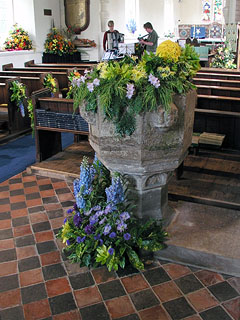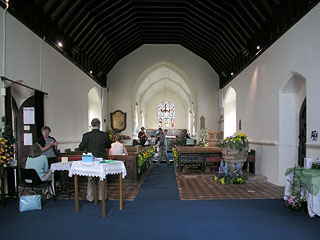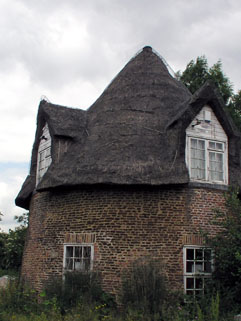Sometimes, to stick in the memory a church doesn't need to be terribly impressive, or picturesque, or possessed of numerous notable historical artefacts. Sometimes it just needs to be alive. I think that's what happened for me with St George - it's a small building, neither grand nor charming, but I think our visit was one of the ones I've enjoyed most in the course of writing this website.
The reason for this is twofold. First, there was a flower festival going on, which filled the church with wonderful colours and shapes. I saw quite a few flower festivals in churches over the summer of 2004 - both in Cambridgeshire and in Suffolk - but I think that St George's one was the best. The displays - each inspired by a different hymn - were rich and inventive, and spoke volumes about the creativity of the congregation and their love for the church. The second reason was that the church was full of people when we visited - some were visiting the festival, some were welcoming visitors and a group of three were playing musical instruments in the corner. It was warm and hospitable, and I felt full of benign Betjeman-like affection.
I'm in danger of gushing, though, so I'd better get on and describe the building for you. It's a very small church - mostly 14th century, though it was extensively rebuilt in the 19th. There's no tower, and the nave is aisleless, so it's almost a cell. The walls look ancient, and the windows are medieval - nice square-headed late Perpendicular ones in the nave, and Decorated 14th century ones in the chancel. The rest of the exterior shows the signs of the later restoration - the porch is certainly Victorian, and so, I think, is the little bell-turret at the top of the west face.
Aside from a bland description like this, I found it difficult to think of much to note here. In my notes I mentioned the headstops on the east window, and the inverted teardrop shapes in the tracery of the nave windows, but I think I was clutching at straws. Inside, things weren't much better - the tiles in the chancel floor caught my attention, but the polychromatic marble reredos is grim, and the Victorian windows aren't terribly exciting anyway.
However, they do have a very fine font. It's large, and very plain - the octagonal bowl and stem are almost unadorned, save for heads sticking out of four faces. They are now terribly mutilated - I could make out a wimple on one, but the features are almost entirely gone - but the whole thing has an impressively primitive feel to it. Admittedly, that's probably more to do with the iconoclasts than the intentions of the carver, but I liked the effect - closer in spirit to a pagan cauldron of rebirth than the refined magnificence of its grander contemporaries.
The font was also
decorated, on that summer morning, with the best flower display of all.
Yellow blooms burst out of the bowl and cascaded over the rim of the
cauldron, and blue delphiniums and cornflowers danced upwards like great
flames. It was inspired by 'Morning has broken', and I thought it so
beautiful that it has stuck in my mind as a constant reminder that it's
not just wooden angels and painted saints that can give a little gift of
joy.
St George was open when we visited.



